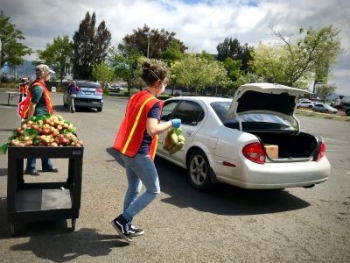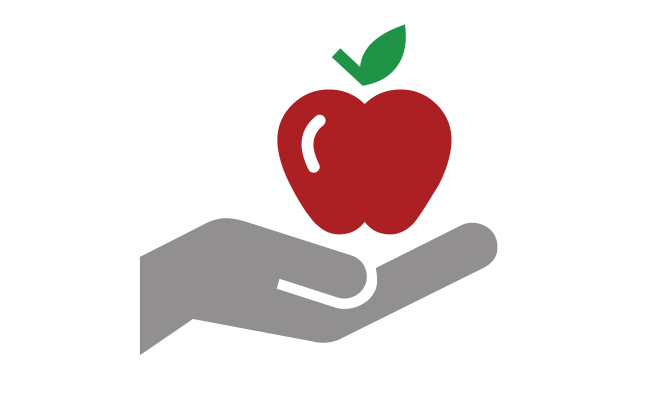Food Recovery Organizations and Services

New State law, SB 1383, and the Alameda County Organics Reduction and Recycling Ordinance went into effect January 1, 2022, including requirements for certain food generating businesses to donate edible food to a local food recovery organization or service and establish contracts or written agreements with them.
Find information about the online reporting portal.
Learn more about all the requirements in the new law at www.StopWaste.org/Rules.
Español (Spanish),中文 (Chinese),한국인 (Korean), and Tiếng Việt (Vietnamese): www.StopWaste.org/Rules-Languages.
Rules for food recovery organizations and services

Effective January 1, 2022, food recovery organizations must:
- Have written agreements with Tier 1 food generators or organizations donating surplus edible food to your organization. Written agreements will not be required for Tier 2 food generators until January 1, 2024. See table below for definitions.
- Maintain monthly records of type, frequency, and pounds of food recovered from Tier 1 donors.
- Report annually the total pounds of food recovered from Tier 1 donors.
If you are member agency of the Alameda County Community Food Bank (ACCFB) Food Recovery Program, some of the above requirements will be completed by ACCFB on your behalf. See below for details on how to become a member agency.
Optional but recommended:
- Report annually the total pounds of food from Tier 1 donors that was spoiled or otherwise not fit for human consumption when received.
- Get added to a public list to help businesses locate donation partners. For more information and to request to be added to the list, complete this short survey.
Request help
Our knowledgeable field team provides free phone, email, virtual, and in-person support to help set up a system to recover and donate surplus edible food.
Food recovery organizations & services report information
On January 2nd, 2024, an online reporting portal will begin accepting entries for your organization to report on the donations you received from Tier 1 and Tier 2 commercial edible food generators during the 2023 calendar year.
The 2023 edible food recovery report from donations received from January 1, 2023, to December 31, 2023, is due on March 31, 2024.
Organizations that have currently been identified have received a mailer physically and digitally with a unique FRO login ID. If you can’t locate your FRO login ID, please contact StopWaste for assistance at rules@stopwaste.org. Alternatively, you can download and complete this fillable report form and email it to rules@stopwaste.org by March 31st, 2024, at 6:00pm.
Schedule of Future Report Due Dates
| Report | Portal Open | Due Date |
|---|---|---|
| 2023 Report | 1/2/2024 | 3/31/2024 |
| 2024 Report | 1/2/2025 | 3/31/2025 |
How to work with donors to comply with the new law
In December 2021, all identified Tier 1 and Tier 2 food generators in Alameda County received a notification letter alerting them to their surplus edible food donation requirements. As a result, businesses may reach out to you as a food recovery organization/service partner. For more information about requirements for food generating businesses, click here. Follow the steps below to ensure compliance when working with existing and new food donation partners.
STEP 1: Assess Your Capacity
Before serving new donors, determine the additional amounts, types, and frequency of surplus edible food your organization can accept. Consider that donations may include more perishable items that require immediate distribution, cold storage, or preservation to remain fit for human consumption.
STEP 2: Enter into Written Agreements
For both existing and new Tier 1 donors, establish a regular food donation or collection schedule with each donor and jointly enter into a written agreement. Maintain copies and update agreements as needed.
STEP 3: Keep Records
Maintain documentation of the types and quantity of food (measured in pounds) recovered per month and the frequency of collections/deliveries from your donors. The first annual report is due August 15, 2022 for donations received January – June. Subsequent reports are due March 31 and annually thereafter. Consider providing records to your donors to help them comply with reporting requirements.
Additional information & free resources
-
Get more information about the new law:
www.StopWaste.org/Rules (all rules) | www.StopWaste.org/Rules-Food-Recovery (food recovery rules) -
Commercial Edible Food Generator Recordkeeping Document: this recordkeeping document was adapted from CalRecycle’s Model Recordkeeping Tool for commercial edible food generators, to ensure compliance with the monthly recordkeeping requirements. The use of this specific tool is optional. The tool can be customized by commercial edible food generators to assist with SB 1383, ORRO or other local ordinance compliance.
-
Food Recovery Organization and Food Recovery Service Recordkeeping Document: this recordkeeping document was adapted from CalRecycle’s Model Recordkeeping Tool for food recovery organizations and services, to ensure compliance with the monthly recordkeeping requirements. The use of this specific tool is optional. The tool can be customized by food recovery organizations and services to assist with SB 1383, ORRO or other local ordinance compliance.
-
Alameda County Community Food Bank (ACCFB) Food Recovery Program: for information about becoming a member, contact Xochi Hernandez at xhernandez@accfb.org.
-
Alameda County Food Recovery Stakeholder Network: connect and build partnerships with fellow organizations involved in edible food recovery. Email Cassie Bartholomew at cbartholomew@stopwaste.org to be added to the invite list.
-
Download StopWaste 2021 SB 1383 Edible Food Recovery Capacity Survey to learn more about Alameda County food recovery organizations and services capacity to recover donated food from Tier One and Tier Two donors.
To file a complaint for a violation of this law, click here.


